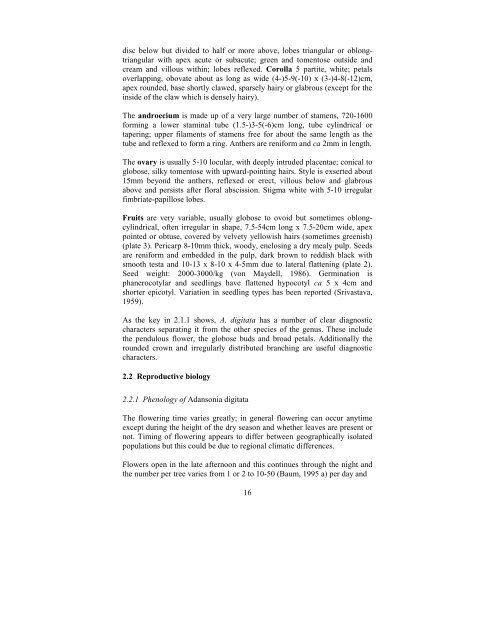Baobab Monograph.pdf - Crops for the Future
Baobab Monograph.pdf - Crops for the Future
Baobab Monograph.pdf - Crops for the Future
You also want an ePaper? Increase the reach of your titles
YUMPU automatically turns print PDFs into web optimized ePapers that Google loves.
disc below but divided to half or more above, lobes triangular or oblongtriangular<br />
with apex acute or subacute; green and tomentose outside and<br />
cream and villous within; lobes reflexed. Corolla 5 partite, white; petals<br />
overlapping, obovate about as long as wide (4-)5-9(-10) x (3-)4-8(-12)cm,<br />
apex rounded, base shortly clawed, sparsely hairy or glabrous (except <strong>for</strong> <strong>the</strong><br />
inside of <strong>the</strong> claw which is densely hairy).<br />
The androecium is made up of a very large number of stamens, 720-1600<br />
<strong>for</strong>ming a lower staminal tube (1.5-)3-5(-6)cm long, tube cylindrical or<br />
tapering; upper filaments of stamens free <strong>for</strong> about <strong>the</strong> same length as <strong>the</strong><br />
tube and reflexed to <strong>for</strong>m a ring. An<strong>the</strong>rs are reni<strong>for</strong>m and ca 2mm in length.<br />
The ovary is usually 5-10 locular, with deeply intruded placentae; conical to<br />
globose, silky tomentose with upward-pointing hairs. Style is exserted about<br />
15mm beyond <strong>the</strong> an<strong>the</strong>rs, reflexed or erect, villous below and glabrous<br />
above and persists after floral abscission. Stigma white with 5-10 irregular<br />
fimbriate-papillose lobes.<br />
Fruits are very variable, usually globose to ovoid but sometimes oblongcylindrical,<br />
often irregular in shape, 7.5-54cm long x 7.5-20cm wide, apex<br />
pointed or obtuse, covered by velvety yellowish hairs (sometimes greenish)<br />
(plate 3). Pericarp 8-10mm thick, woody, enclosing a dry mealy pulp. Seeds<br />
are reni<strong>for</strong>m and embedded in <strong>the</strong> pulp, dark brown to reddish black with<br />
smooth testa and 10-13 x 8-10 x 4-5mm due to lateral flattening (plate 2).<br />
Seed weight: 2000-3000/kg (von Maydell, 1986). Germination is<br />
phanerocotylar and seedlings have flattened hypocotyl ca 5 x 4cm and<br />
shorter epicotyl. Variation in seedling types has been reported (Srivastava,<br />
1959).<br />
As <strong>the</strong> key in 2.1.1 shows, A. digitata has a number of clear diagnostic<br />
characters separating it from <strong>the</strong> o<strong>the</strong>r species of <strong>the</strong> genus. These include<br />
<strong>the</strong> pendulous flower, <strong>the</strong> globose buds and broad petals. Additionally <strong>the</strong><br />
rounded crown and irregularly distributed branching are useful diagnostic<br />
characters.<br />
2.2 Reproductive biology<br />
2.2.1 Phenology of Adansonia digitata<br />
The flowering time varies greatly; in general flowering can occur anytime<br />
except during <strong>the</strong> height of <strong>the</strong> dry season and whe<strong>the</strong>r leaves are present or<br />
not. Timing of flowering appears to differ between geographically isolated<br />
populations but this could be due to regional climatic differences.<br />
Flowers open in <strong>the</strong> late afternoon and this continues through <strong>the</strong> night and<br />
<strong>the</strong> number per tree varies from 1 or 2 to 10-50 (Baum, 1995 a) per day and<br />
16

















